This post contains affiliate links.
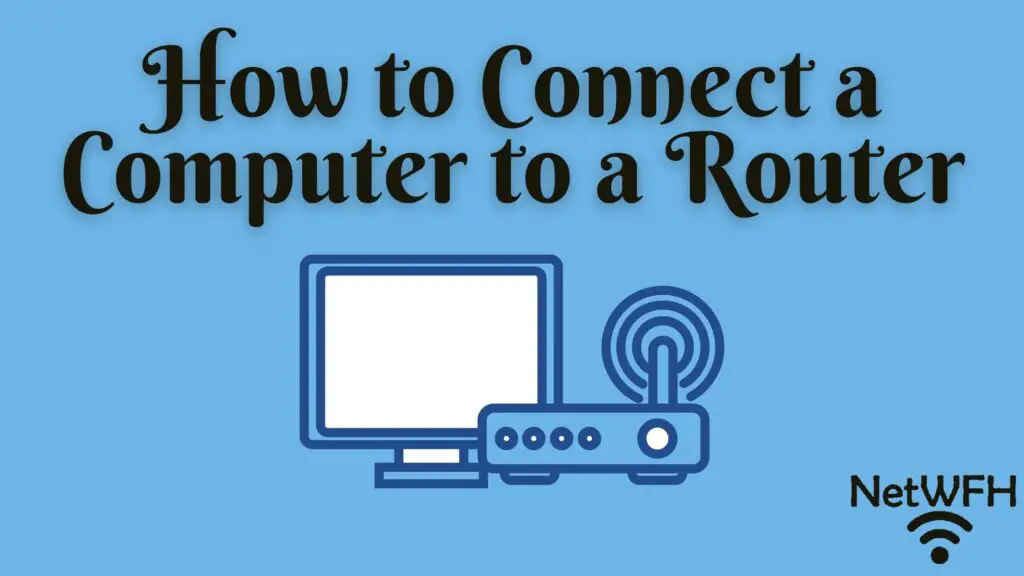
If you want your computer to be able to access the internet in your home, you need to connect it to a router.
The same applies for your home network. You need to connect your computer to your router if you want it to be able to communicate with other devices on your home network.
There are two ways to accomplish this. You can either connect your computer to your router directly through a wired connection, or you can connect the two devices wirelessly.
The good news is, both of these procedures are pretty easy. Each one should take you less than a few minutes to complete.
You should know both ways of connecting your computer to a router. There are situations where one way of connecting to your router will give you better performance than the other connection method.
When connecting to your router with a wired connection, you just need an ethernet cable. The ethernet cable connects your computer and router so they can directly communicate with each other.
All you have to do is connect the ethernet cable to the right ports on your computer and router.
In a wireless connection, your computer will connect to your router over WiFi. This allows them to communicate without an ethernet cable.
For this type of connection you’ll need to connect to the wireless signal that’s coming from your router. You won’t be able to do this without the password for your router’s wireless network.
In this post I’ll go into detail about the procedures for connecting your computer to your router. I’ll also explain the benefits of each type of connection.
Why you need to connect to a router
You may be wondering: why does my computer need to connect to a router in the first place?
To answer that question, we need to look at what a router does.
The purpose of a router
I will keep this at a high level.
Your router is responsible for directing the traffic between the devices on your home network. If you have an internet plan (as I assume you do if you’re reading this), your router also manages traffic between your internet devices and the internet. When your devices request information from the internet, your router makes sure that the requests make it to the right place.
When a response comes back from the internet with the requested information (like a webpage), your router ensures the device that asked for the information is the one that receives it.
A common analogy for your router is the post office. Much like a post office makes sure your letters get to the right destination, your router does the same with your internet requests.
Without a router, your devices wouldn’t be able to connect to the internet in the first place.
Benefits of a router
Ok, now we can get back to the question at hand.
Why can’t your computer access the internet without a router?
Although it’s possible to get internet access without a router by connecting your computer directly to your modem, it’s not secure or smart to do so.
Your router makes your devices more secure on the internet because it has security features built into it.
On top of that, your router allows you to connect multiple devices to the internet at the same time.
How does it do this?
Your router is connected to your modem (or they are combined into one device). These two devices provide you with a connection to your internet service provider (ISP).
In turn, your ISP provides you with your internet connection.
Here’s a diagram to help you visualize your home network connections:

The important thing here is that your ISP provides you with only one connection to the internet as part of your internet plan.
If you didn’t have a router, you’d only be able to connect one device to the internet at a time because you only have one connection to the internet available.
Could you imagine how painful that would be?
This is the main reason why you need to connect your computer to a router. To put it simply, it’s because your router allows all of your internet devices to share one internet connection.
In today’s society, everyone has multiple devices connected to the internet at the same time. This is normal thanks to your router.
Without a router, you couldn’t do that.
Hopefully you now have a good understanding of why your computer needs to connect to a router.
With this background information, let’s look at the procedures for connecting your computer to your router.
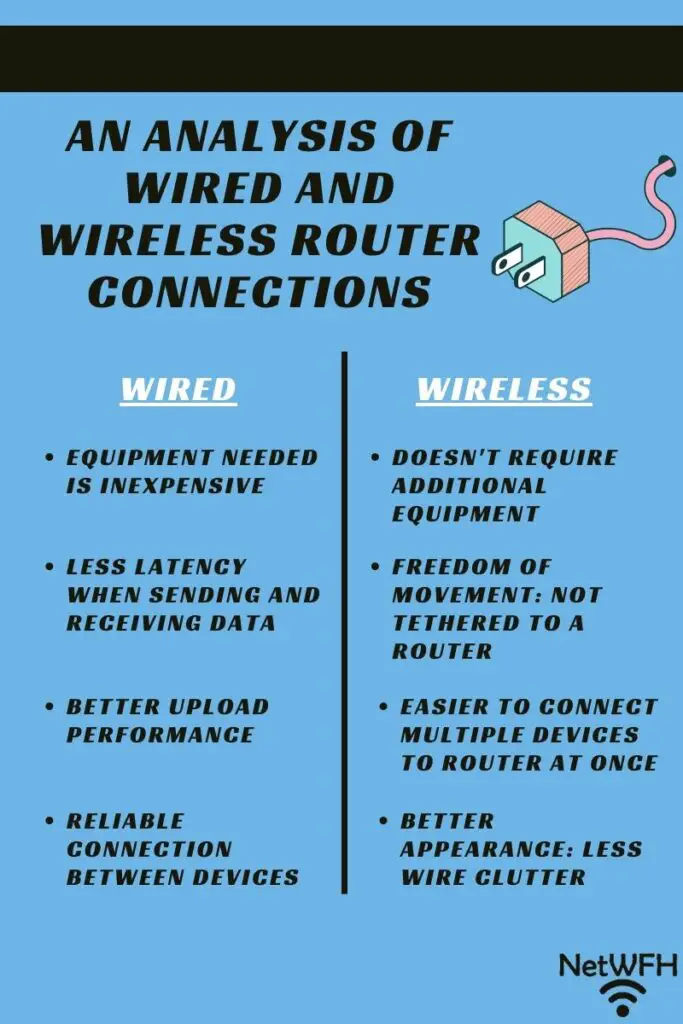
Connecting a computer directly to a router
The first way you can connect your computer to your router is through a direct connection.
A direct connection involves using a cable to connect your computer and router. This allows the two devices to communicate through the cable.
Benefits of directly connecting a computer and router
Connecting your computer and router with a cable provides multiple benefits.
Faster performance
For one, it’s the most straightforward way for the two devices to communicate.
Using a cable to communicate reduces the latency in their connection. This means that data moves faster between the two devices when they’re communicating.
In other words, when you request a website you’ll receive it a little bit faster from your router with a cable connection.
This is also very important in online gaming. Every millisecond counts.
When you press a key on your keyboard, the game will respond faster when you have your computer directly connected to your router. Faster reactions give you an advantage over other players who have more latency in their internet connection.
Lastly, a wired connection will provide better performance during uploads when compared to a wireless connection. This is important when uploading large files to the internet or during video conferences.
More reliable connection
Connecting your computer directly to your router provides another major benefit.
A more reliable connection.
When you use a cable to connect these two devices, it’s unlikely that the connection between the two will drop.
On the other hand, if you try to connect to your router wirelessly, you’re much more likely to lose your connection.
I’m sure this has happened to every person reading this.
Like that time you walked out of range of your WiFi signal and lost your internet connection?
Yeah, that’s happened to me too.
You don’t have to worry about that when connecting your computer and router with a cable.
The only way you’ll lose the connection between the two is if something is wrong with the cable. That’s not a likely scenario as the cables are manufactured to be very reliable.
Very rarely will you experience issues with them.
What you’ll need to connect your computer to your router
The only thing you’ll need to connect your computer to your router is a cable.
These cables are called ethernet cables.
The only thing you have to worry about is making sure you get the right cable based upon the internet connection you have.
Thankfully, this is an easy exercise because there’s one type of cable that’ll fit all your needs. If you don’t have an ethernet cable on hand, grab a snagless Cat5e ethernet cable of the length you need. I would suggest a seven to ten foot cable, but you may need longer based upon your home layout.
A Cat5e ethernet cable will fit your needs here regardless of the internet plan you have. On top of that, ethernet cables are inexpensive so it won’t cost you much to implement a wired connection.
How to connect your computer to your router with an ethernet cable
Once you have an ethernet cable to connect your computer to your router, it’s a pretty easy process.
In this example I’ll use my yellow ethernet cable.
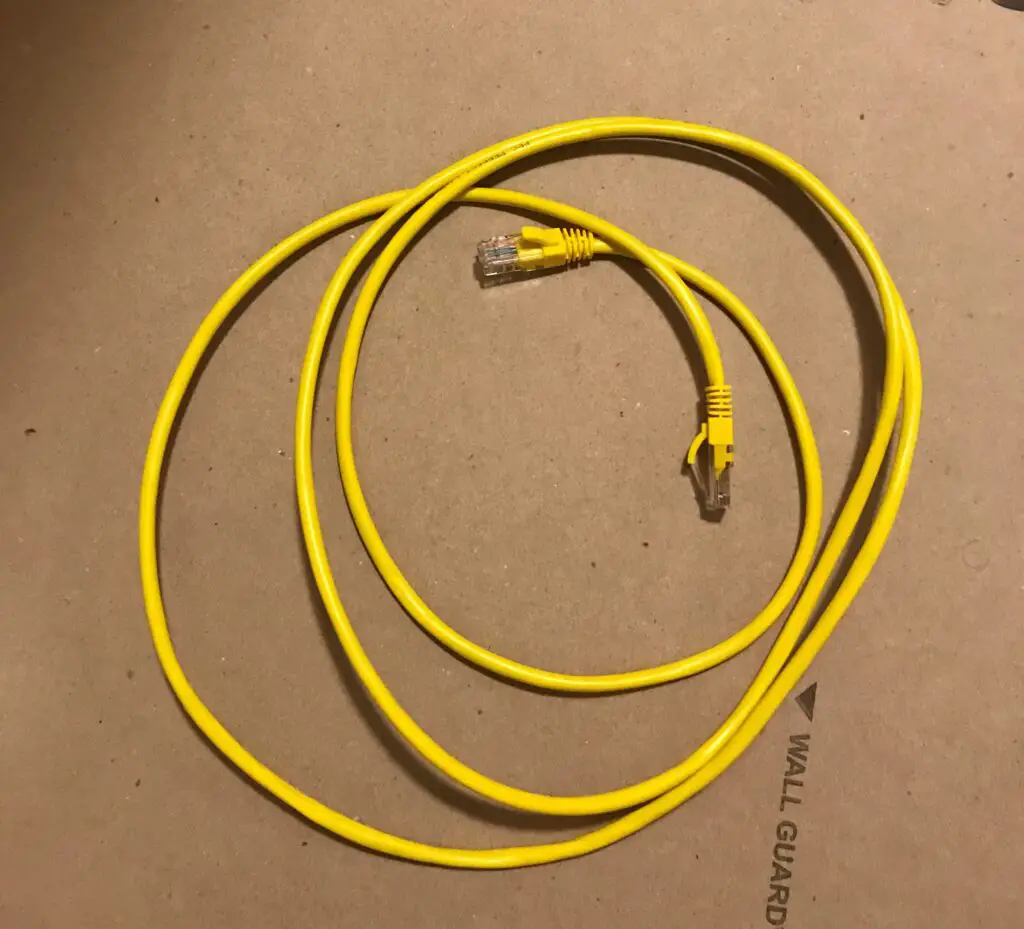
Connect the ethernet cable to your router
First, let’s find where the ethernet cable plugs into your router.
Depending upon the type of router you have, it’ll have a certain number of ports that you can directly connect your devices to.
These are called LAN ports. LAN stands for Local Area Network and in this case LAN is used to describe your home network.
In most cases, there will be four LAN ports on your router.
As you can see, my router has four LAN ports that are labeled “Ethernet”.
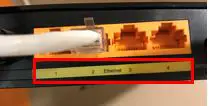
All you have to do is plug one end of your ethernet cable into an open port. The beauty is, it doesn’t matter which port you use or which end of the cable you plug in. Any open port will do.
To prove my point, I’ll plug my ethernet cable into port 4.
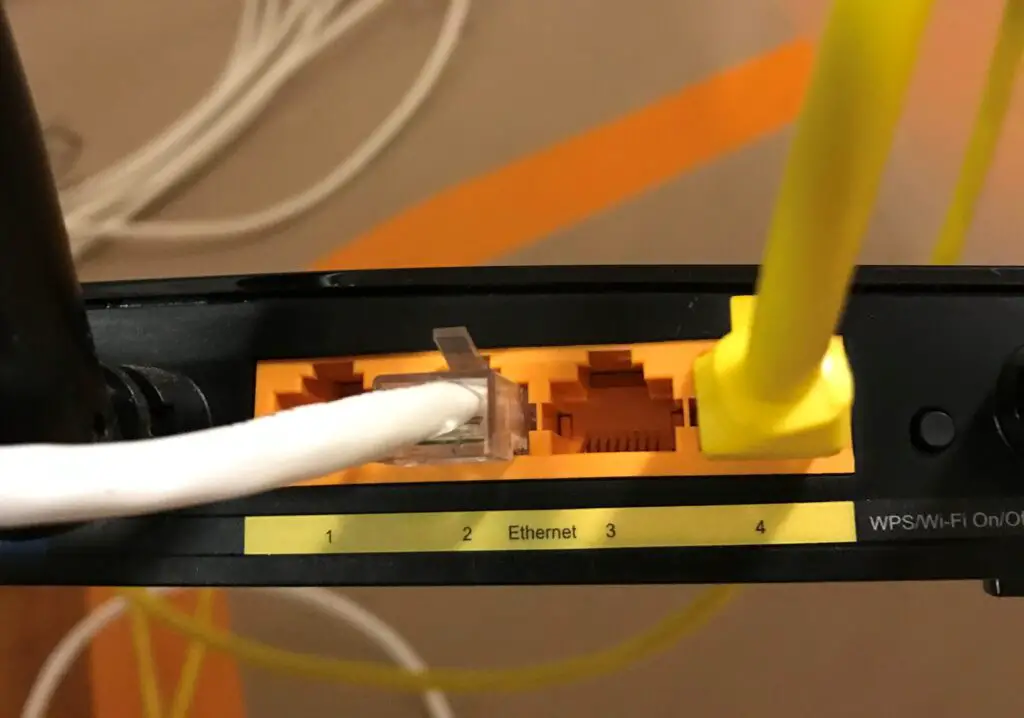
Connect your ethernet cable to your computer
Ok, we’re halfway there.
Now we just need to plug the other end into our computer.
What does that look like?
If you look at your computer, you should have a port that looks like one of your router’s LAN ports.
On my laptop, the LAN port is on the side.
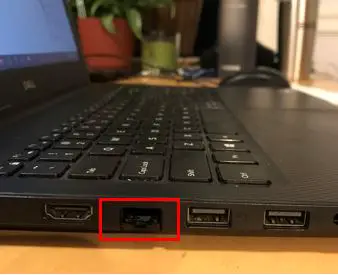
As you may have guessed, we just need to plug the other end of our ethernet cable into this port.
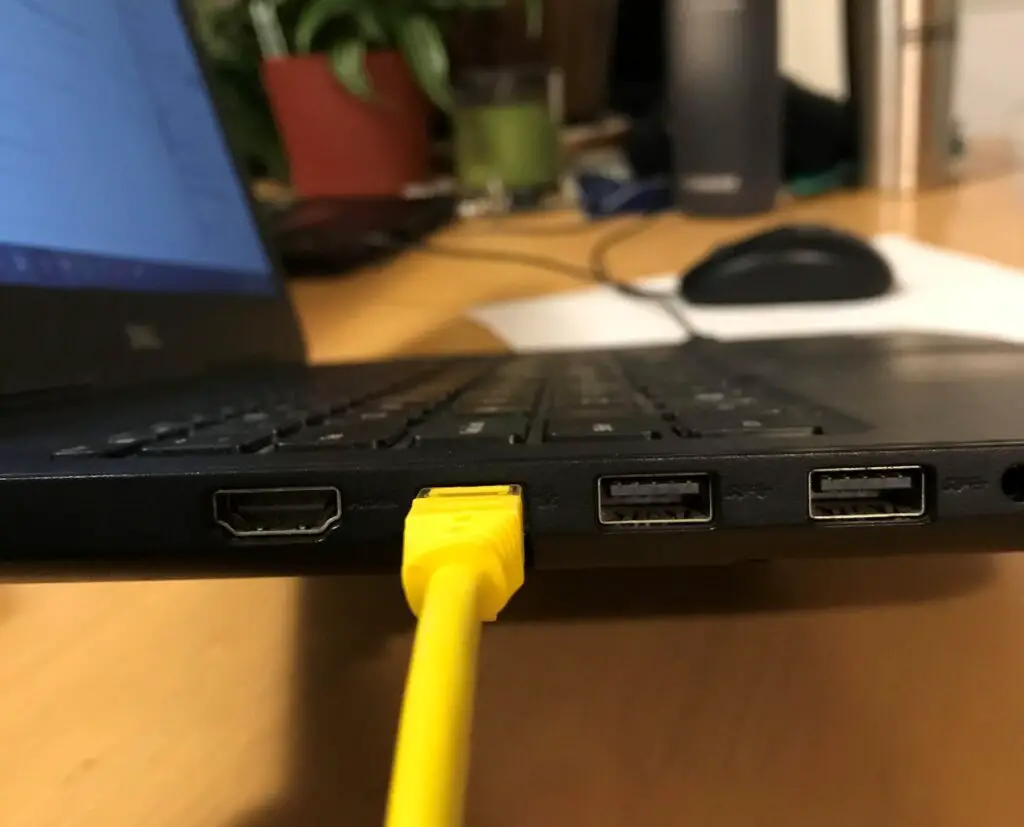
Congratulations. You’ve connected your computer and router together.
The wired connection is complete and your computer and router can now communicate over the ethernet cable.
If the wired connection is working, there should be an indicator in the corner of your computer indicating you have a wired network connection.

So long as your router has an internet connection, you can now use the internet with a faster, more reliable wired connection.
What if my computer doesn’t have an ethernet port?
Recently, I’ve seen a trend of computers not having an ethernet port.
If your computer doesn’t have an ethernet port, fear not. All is not lost.
You can still connect an ethernet cable to your computer. You just need an adapter.
What you’re looking for is a USB plug with an ethernet cable adapter. This’ll basically take one of the USB ports on your computer and turn it into an ethernet port.
As a reminder, the USB ports on your computer will look like this:
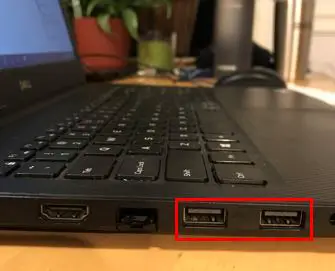
Your computer will most likely have multiple USB ports, so hopefully you have an open USB port to use.
When looking for a USB to ethernet adapter, there are many choices online. I recommend this one from Uni. It has all the latest technology in terms of USB and ethernet connections, so you don’t have to worry about it limiting your connection.
Grab one of those and you’re good to go. Just plug the adapter into one of the USB ports on your computer and then plug your ethernet cable into the adapter.
It doesn’t get any easier than that.
Connecting a computer to a router over WiFi
Ok, now we’ve covered connecting your computer to a router with an ethernet cable.
Let’s look at the other option: connecting your computer to a router wirelessly.
A wireless connection allows you to connect to your router and access the internet without an ethernet cable. This happens over WiFi.
Don’t let the term confuse you. WiFi is simply the technology used to connect devices wirelessly.
Your router broadcasts a wireless network signal to all your wireless internet devices. Your devices receive the signal and can establish a connection with your router over this wireless network.
Once a connection has been created, your router and devices can communicate as if they were connected to each other with an ethernet cable. The only difference is they’re sending data to each other through the air.
Benefits of connecting a computer to a router over WiFi
How is a wireless connection different from a wired connection? Are there any benefits to communicating wirelessly?
You bet there are.
Freedom from your router
The main benefit of connecting to your router wirelessly is the obvious one.
You don’t need a cable between the two devices in order for them to communicate. In other words, connecting to your router wirelessly can be so much more convenient.
In fact, you don’t even have to be in the same room as your router to connect to it. You also have the ability to move around with your computer without losing a connection.
On the other hand, if you tried to move around with a wired connection to your router you’d look like the fish on the end of a line. It’s not the easiest thing to do.
Easier to connect multiple devices to your router at the same time
Wireless connections also allow you to connect more devices to your router at one time. As we saw above, most routers only have 4 ethernet ports on them. If you have a lot of internet devices you want to connect to your router with a wired connection, things can get messy.
Even with an ethernet switch, there’s only so many devices you can connect to your router before the wiring gets really confusing.
Less clutter
For those concerned with appearances, this is another benefit of connecting to your router wirelessly. The less ethernet cables you have coming from your router, the cleaner your home will look.
You don’t have to worry about trying to hide the rats nest of ethernet cables coming from the back of your router. For some, this is more important than others.
The last thing I’ll say is that although a wireless connection may have higher latency than a wired connection, this doesn’t mean you can’t or won’t have a fast internet experience.
We are talking about a difference of milliseconds here. Unless you’re measuring it you probably won’t be able to notice.
What you’ll need to wirelessly connect your computer and router
Compared to a wired connection, you need even less to connect your computer and router wirelessly.
All you need is a computer and a router.
The only situation where you may need another item is if your computer doesn’t have WiFi capability.
This is unlikely as your computer would have to be really old for it to not have wireless technology.
If for some reason this is the case, you just need a wireless adapter. It plugs into one of your computer’s USB ports and it enables your computer to communicate with other devices over WiFi.
If you need a wireless adapter, check this one out. It should provide you all you need to wirelessly connect to your router. It’ll also support any internet plan so you don’t have to worry about it slowing down your internet speed.
How to connect your computer and router over WiFi
Let’s say your computer and router are both powered on and ready to go.
Now what? How do we get them to connect to each other?
Determine the SSID you want to connect to
To make things easy on you, the remaining steps can be done from your computer.
All you have to do is connect to your router’s wireless network. Another name for your router’s wireless network is its Service Set Identifier, or SSID.
Your SSID will be the custom name you chose for your network when setting up your router.
If you haven’t created a custom SSID, your router’s SSID will be the default one that it came with. You should be able to find the default SSID information on a sticker on your router.
For example, here’s the default SSID information on my router’s sticker.
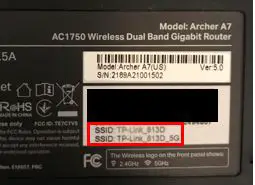
Once you’ve determined the SSID you’re looking for, you need to find it in your computer’s Network and Internet settings.
Find the desired SSID in your computer’s internet settings
As a disclaimer, the following instructions are for Windows computers. The steps will be slightly different for Mac users.
Ok, let’s find the Network and Internet settings on your computer.
First, click the little Windows icon in the corner of your computer. This’ll pull up a list of options. Select “Settings”.
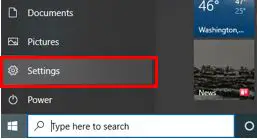
In the window that opens, you need to select Network & Internet. This’ll show you all your network options and settings.
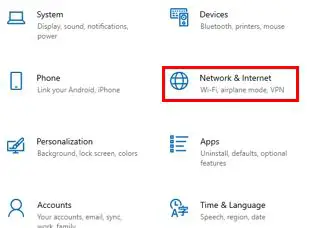
A new window will open. Select “Wi-Fi” in the side toolbar. Clicking it will show you all your WiFi options.
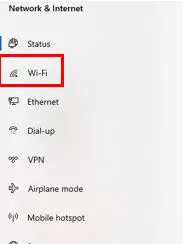
In the WiFi settings page, the last thing you need to do is select “Show available networks”.
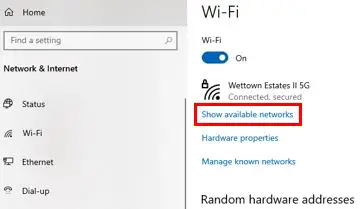
When you select “Show available networks”, a list of available wireless networks will be listed for your computer.
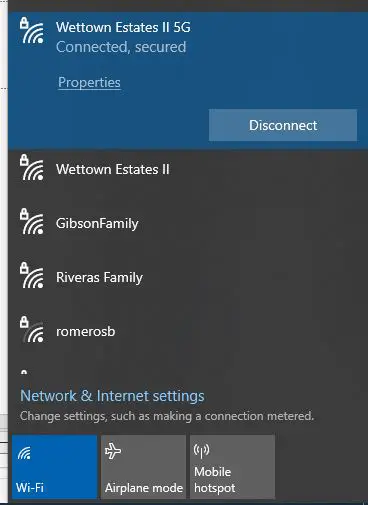
Make sure your computer is close to your router at this time so its SSID shows up in the list of available options.
If you see your router’s SSID in the list of available networks, select it and you’ll be prompted to enter the network’s password.
Enter the password for your SSID
If you’ve set up a custom SSID for your network, you’ll probably have created a custom password for it as well. Enter this custom password here to connect to your wireless network.
If you haven’t created a custom SSID and password for your router’s network, you can find the password for the default SSID on the sticker on your router. It may be listed as either “Wireless Password”, “Wireless Pin”, or “Wireless Passcode”.
Here’s what it looks like on my router.
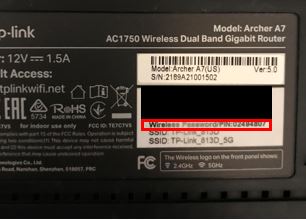
Upon correctly typing in the SSID’s password, you’ll be connected to your router’s WiFi network.
Well done! You’ve successfully connected your computer to your router over WiFi.
You’ll know you have a wireless connection if you can see the little WiFi icon in the corner of your computer near the date and time information.

Wrap up
You’re now armed with the ability to connect your computer to your router. You can either connect the two devices directly with an ethernet cable, or you can connect them wirelessly.
If you have any trouble connecting to your router or you have any questions about the information I provided, please leave a comment below. I’d love to help.
If you found this information interesting, check out some other posts I’ve written about similar topics:
What Do My Router Lights Mean?
Can I Use a Router Without a Modem?
Can I Move My WiFi Router to Another House?
